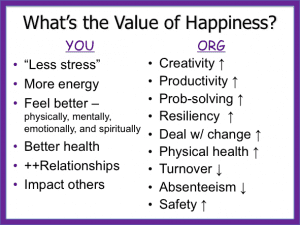Happiness is Noticed for its Absence…
Picture this: I am sitting in a room with a leadership team who are frustrated with high levels of behavior often associated with employee disconnection: turnover, absenteeism, gossip, backbiting, lack of discretionary effort, cliquishness, zero input during meetings, constant griping about even the tiniest things, and a pervasive sense of overwhelm. They “admire the problem” from multiple perspectives and declare, “Fix this, we must!”
Yet when the conversation turns to potential solutions, we are suddenly in a conversation of “oh, we can’t afford that kind of expense.”
Really?! But you CAN afford to have a revolving door of employees, a workforce that is unengaged, and people in leadership roles who feel stressed and overwhelmed?
Since I was a CFO in a past life, I have little tolerance for conversation where people focus only on expense without calculating potential return on their investment.
Most of my posts over the past 10 years have addressed the HOW you create more happiness in life and at work. This post is about the WHY leaders need to pay attention.
Because dollars. Happiness and dollars. 🙂
The Value of Happiness
This slide summarizes the outcomes impacted when you and or your organization hold a positive perspective on life and work.
Individuals who nurture happiness and positive emotions report feeling better in all domains of their life (physical, mental, emotional, and spiritual); have better health outcomes (sick less often–and when they are sick, quicker recovery); better short-term and long-term relationships; more energy, and a different relationship with stress.
It’s not that happier people don’t experience challenges in life, rather that they have a different relationship with them. Happier individuals tend to look at obstacles and setbacks as temporary, whereas individuals who do not nurture positive emotions tend to see obstacles or setbacks as permanent, and happiness as temporary and elusive.
How do those individual benefits accumulate at the group level? Here are 11 Organizational Benefits to nurturing Happiness in the workplace:
1. Creativity. Being creative is a natural talent we are all born with. Fear and stress cause us to shrink back and avoid risk, stifling creativity. Happy people feel more comfortable offering their best ideas.
2. Productivity: Here is a 2014 study which suggests that raising people’s happiness makes them more productive by between 7% and 12%. What CFO is going to turn their nose up at a 10% return on investment? Remember that this increase in productivity is achieved without increasing payroll. We’re talking Big Dollars here! If you had 50 employees, averaging $60,000 in base pay ($3MM payroll), you could invest $100,000 a year in leadership development, employee perquisites, working conditions, and teambuilding ($2000 per year per employee) toward improving your culture and workplace positivity, and still have a 200% return on your investment, despite having “expensed $100,000,” which feels like a lot of money until you think about it as an investment.
3. Problem-solving. Happy people find it easier to step outside of their own perspective and look at situations from multiple perspectives. Combined with a higher level of comfort in the creative space, happy people are better at solving problems.
4. Resiliency. Again, it’s not that happy people don’t experience the same life and career setbacks that plague us all. It’s just that those who practice gratitude and optimism find it easier to regain their balance and bounce back. This leads to the next point about employees which is:
5. Dealing with change. Organizational and environmental change–at the speed of life–is a constant. Humans are biologically programmed to resist change when they first encounter it. Those who are better at bouncing back or quickly adjusting their stories to accept a new reality find change easier to absorb. Organizations that understand this may even screen for happiness as they hire and promote people. The larger the percentage of positive-minded people in an organization, the more rapidly that organization can dance with change.
6. Physical health. After payroll, medical benefits are the second largest people expense in most organizations. Even before Positive Psychology came along, most healthcare professionals could tell you that those who entered the healthcare space with a positive mental attitude recovered more quickly than those with a negative or victim mindset. Happier people, basically, get sick less often and recover more quickly, which decreases healthcare expense.
Most human resources and finance professionals are familiar with the incredible numbers associated with nurturing wellness in their organizations. In organizations with a more positive workplace culture and higher trust levels, a higher percentage of employees take advantage of those wellness programs, which translates into reduced healthcare dollars, a virtuous cycle any CFO will love.
7. Turnover. People in a more positive workplace want to stick around longer. Period. I recently worked through the numbers for a client experiencing 50% turnover. They only have 50 employees (well-compensated professional staff) yet we found the cost of avoidable turnover exceeds $850,000 a year — what it’s costing that organization to lose people they want to keep BUT who are leaving because they feel unhappy, disconnected, and overly stressed. What’s your number?
8. Absenteeism. Happy employees, again, are sick less often and for less time. That means they are on the job more.
9. Safety. Studies in manufacturing environments show strong correlation between positive workplace morale (a.k.a. happiness) and incidence of rule violations and workplace accidents. Happy employees care more and make fewer mistakes.
And a few new findings that are not on the above chart:
10. Morality/ethics. A happier person finds it easier to think about the welfare of others and tends to cast a wider net of concern about the impact of their actions. Now, think about any high profile corporate meltdown/corruption story from recent history. Can you think of a single case where the description “dysfunctional” or highly stressed did not occur in the description of the workplace culture?
Do you ever hear about happy workplaces with high incidence of on the job harassment, ethics violations, or embezzlement? No. You do not. And there is a reason why you do not. People don’t treat others poorly when they’re themselves happy!
11. Acceptance of others/non-judgmental. When you look behind nearly every story of exclusion, discrimination, harassment, or systemic prejudice, you will find a story of scarcity and fear (e.g. “There’s not enough for all of us,” it’s a zero-sum game). Happy people live more often in a story of abundance and gratitude, and find it easier to hold the possibility that everyone can benefit in some way from any potential solution.
Happiness has Value; Unhappiness has a Cost
Whether you are a CFO, a business owner, a steward of your corporate culture, a manager at any level, or a frontline employee who is interested in the success of your organization, notice that taking care of your happiness and paying attention to the happiness of those around you will benefit both you and your team.
Remember, Leadership is not about a title; anyone can be a Leader who makes their own Happiness a priority so that when they come to work, they serve as a positive influence for others!
Be Happy. Lead Well.


